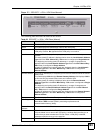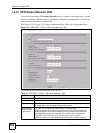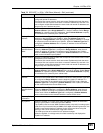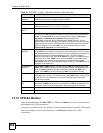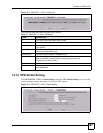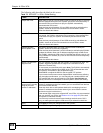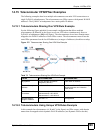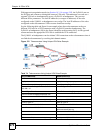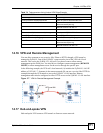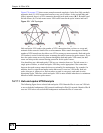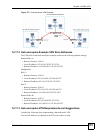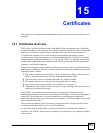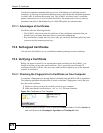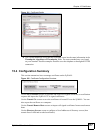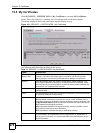
Chapter 14 IPSec VPN
ZyWALL 2 Plus User’s Guide
271
14.16 VPN and Remote Management
You can allow someone to use a service (like Telnet or HTTP) through a VPN tunnel to
manage the ZyWALL. One of the ZyWALL’s ports must be part of the VPN rule’s local
network. This can be the ZyWALL’s LAN port if you do not want to allow remote
management on the WAN port. You also have to configure remote management (REMOTE
MGMT) to allow management access for the service through the specific port.
In the following example, the VPN rule’s local network (A) includes the ZyWALL’s LAN IP
address of 192.168.1.7. Someone in the remote network (B) can use a service (like HTTP for
example) through the VPN tunnel to access the ZyWALL’s LAN interface. Remote
management must also be configured to allow HTTP access on the ZyWALL’s LAN interface.
Figure 177 VPN for Remote Management Example
14.17 Hub-and-spoke VPN
Hub-and-spoke VPN connects VPN tunnels to form one secure network.
Local ID Type: DNS Peer ID Type: DNS
Local ID Content: telecommuterb.com Peer ID Content: telecommuterb.com
Local IP Address: 192.168.3.2 Remote Gateway Address:
telecommuterb.dydns.org
Remote Address 192.168.3.2
Telecommuter C (telecommuterc.dydns.org) Headquarters ZyWALL Rule 3:
Local ID Type: E-mail Peer ID Type: E-mail
Local ID Content: myVPN@myplace.com Peer ID Content: myVPN@myplace.com
Local IP Address: 192.168.4.15 Remote Gateway Address:
telecommuterc.dydns.org
Remote Address 192.168.4.15
Table 74 Telecommuters Using Unique VPN Rules Example
TELECOMMUTERS HEADQUARTERS



